Buffalo & Hobo Nickels
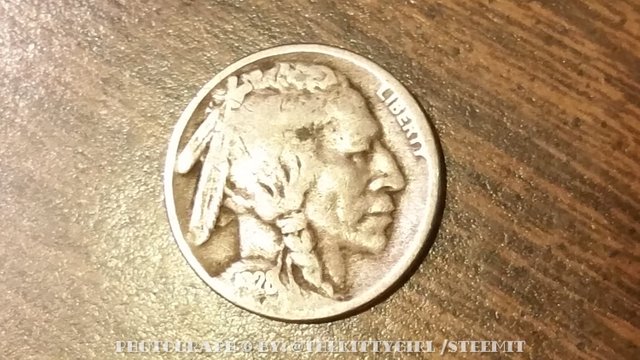
"...when I was asked to do a nickel, I felt I wanted to do something totally American — a coin that could not be mistaken for any other country's coin. It occurred to me that the buffalo, as part of our western background, was 100% American, and that our North American Indian fitted into the picture perfectly." [2]
So, Fraser's design was accepted and approved for the obverse (front) of the coin, and the initial "F" can be seen beneath the date to honor his contribution as designer of the coin:
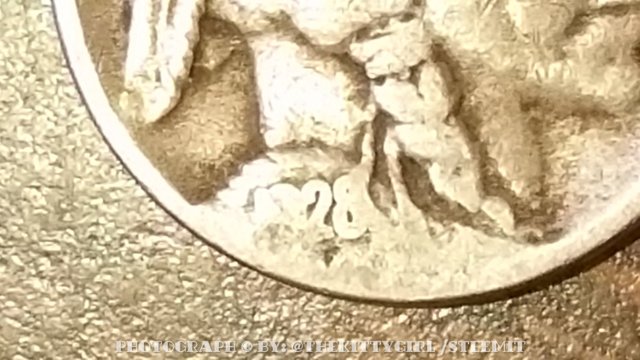
Many people wondered about the identity of the man depicted on the coin. Fraser stated in 1913 that he had executed portraits of several Native Americans and then sought to combine their features into one masterpiece that represented an archetype, rather than any one individual. Despite this, there were people who came forward later, claiming to be the subject of the portrait, to which Fraser always responded with a list of names which did not include the claimant.
Before this coin, most US coins featured feminine figures such as Lady Liberty. The issuance of this nickel broke from that tradition, which made it a curiosity and thus very popular. [3]
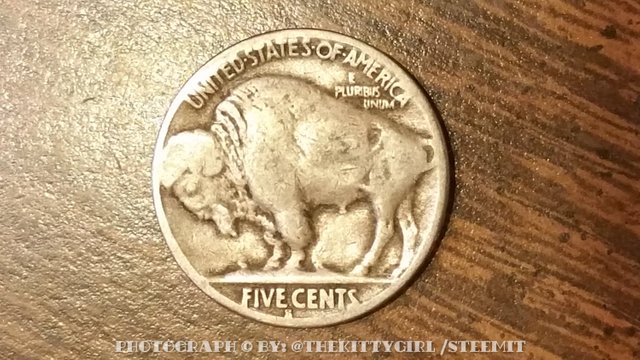
The reverse (back) of the coin features a buffalo, which is an American colloquialism for the North American bison. [3] Below the denomination on the back of this 1928 nickel is the mark "S" for the San Francisco Mint.
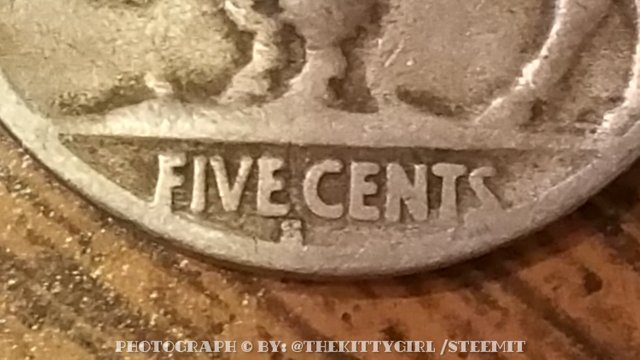
Then, the dies used to strike the new coins wore to an unacceptable state three times as quickly as the dies for the previous nickels with the Liberty Head design. This necessitated the production of new dies on a frequent basis. Small adjustments were made to the design, but the dies continued to wear substantially. Also, the coins in circulation tended to show wear much faster than previous nickles, and today it is difficult to find a specimen that doesn't show some wear (except, of course, for the "proof" coins minted for collectors). One such example is another coin in my collection in which the date is completely missing from years of handling before it ever reached me, long ago:
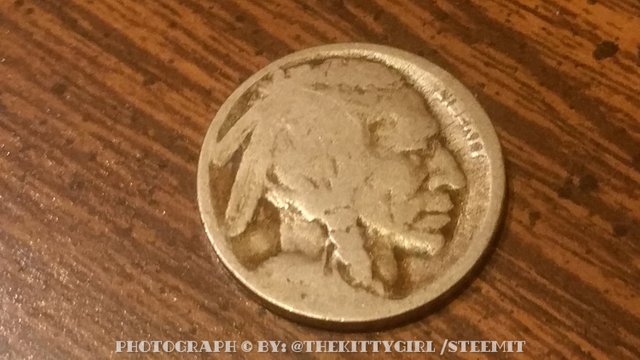
One can also see that the rim of the coin is no longer a uniform evenness around the circumference of the coin's face. This coin supposedly used the same alloy as its precursor, the Liberty Head nickel, which was 75% copper and 25% nickel, so the design had to be at fault (larger bust/portrait, less background field, etc.).
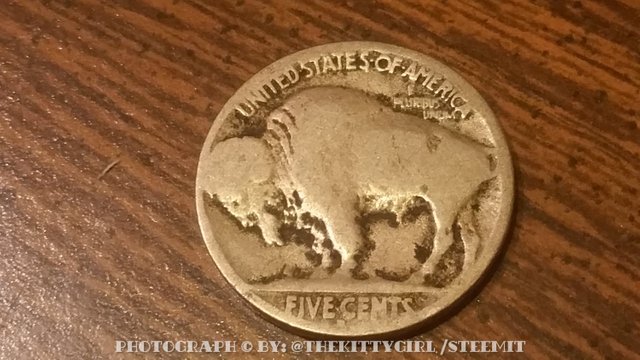
Even with all the wear the coins exhibited during circulation, it remains one of the most exciting coins ever to be circulated. I remember as a child in the 1960s that it was exciting to be handed one of these in-change from a store clerk! I just wish I'd had the forethought to have saved every one of them, plus the old dimes and quarters as well, which I had while I was a child, as they would be worth a small fortune today!
Because the portrait on the Buffalo Nickel was so much larger than that of previous coins, it attracted the attention of amateur engravers. At first, it was a hobby of the hobo community, and such modified coins came to be known as "Hobo Nickels."
...hobos did not associate themselves with "bums" or 'tramps...' True hobos were nomadic and free-spirited... but adhered to an informal code of hobo ethics, worked hard when work was available, and tried to stay away from trouble. [1]
I wondered about the legality of altering a US coin, so I went searching for the answer. According to the Professional Coin Grading Service (PCGS), one of the authorities in the field of numismatics:
In the eyes of the U.S. Treasury Department, hobo nickels are, officially, only former legal tender mutilated beyond recognition and, therefore, worth absolutely nothing. But to numismatists everywhere, these coins are more special than gold. Chances are that one will never encounter a hobo nickel unless actively searching for one. [1]
Further reading of an article titled "U.S. Coin Mutilation Laws" from "The E-Sylum" electronic publication of the Numismatic Bibliomania Society on the website CoinBooks.org offers further insight into this question:
[U.S. LAW CODE] Title 18, Section 331 states,"Whoever fraudulently alters, defaces, mutilates, impairs, diminishes, falsifies, scales, or lightens any of the coins coined at the mints of the United States, or any foreign coins which are by law made current or are in actual use or circulation as money within the United States, shall be fined under this title or imprisoned not more than five years, or both."This law enacted in 1909 was strictly enforced at first, bringing an abrupt end to countermarking, elongating, carving, cutting away blank fields, and pushing out reliefs on coins.
The Treasury Department, however, has come to view the decree as hinging on its second word: fraudulently. Examples of fraudulent tampering are the ancient practice of shaving metal off the edges of solid gold coins, or the 1883 practice of making "racketeer nickels." (When the Mint issued a nickel design which did not bear the words FIVE CENTS on the reverse, but instead employed a Roman numeral V just like the one on the $5 gold piece, some miscreants plated gold on their nickels and passed them as $5 pieces.)
Section 331 takes aim at these types of deceptions, but not at the creation of coin novelties. The law was probably responsible for the practice of stickering and capping coins, which enabled advertising on coins without altering them. Elongated roller machines did disappear for a while, but the law never stopped kids from putting pennies on the railroad tracks!
So, the carving of artwork — without fraudulent intent — doesn't appear to be breaking any laws, although it strips the status of "legal tender" from the coins while replacing it with artistic and collectible value. Apparently, the artwork appears to have been appreciated by some folks and the original Hobo Nickels were widely traded for small favors. [1] There appears to be an ongoing tradition, even today, with some artists executing their own artwork on Buffalo Nickels. I found an example of some such artwork, shown below. I really like that third coin in the second row! That is gorgeous and I'd love to have that one in my collection!
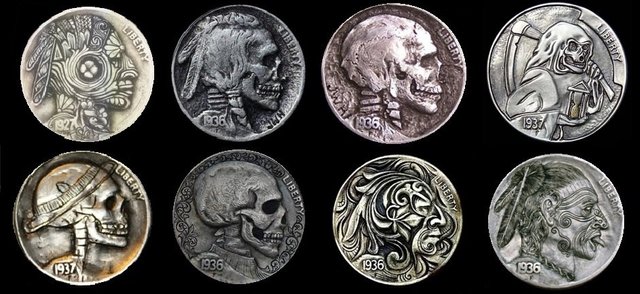
DETAIL OF PHOTO BY DAN THOMS, CC BY-SA 4.0, WIKIPEDIA.COM
So, do any of you dear readers have Buffalo Nickels or Hobo Nickels? If so, please consider sharing them with us!
 😊
😊SOURCES
1 PCGS.com: A History of Hobo Nickels...
2 Wikipedia: Buffalo Nickel
3 Wikipedia: Hobo Nickel
4 Wikipedia: Libertas
5 Coinbooks.org: US Coin Mutilation Laws

a big hug to @enginewitty for designing the following personal banner for me 🤗





I've got a Hobo Nickel replica in Silver . . . here's the post and pic...
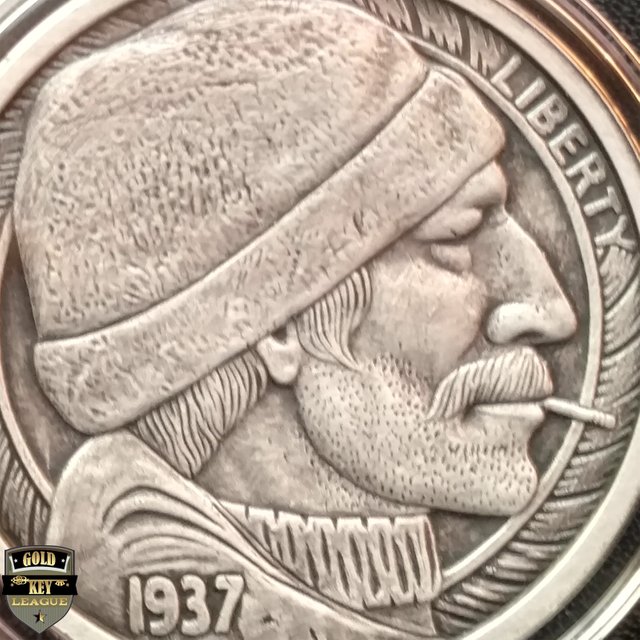
https://steemit.com/steemsilvergold/@goldkey/coin-shop-quickie-silver-hobo-nickel-the-fisherman-antique-20180726
wow!!!!!! that is so cool!!!
howdy there thekittygirl! I love this article, it's so educational, informative and interesting! great job!
A very informative article, @thekittygirl! Stack on, my friend!
I remember as a child my mom would get buffalo head nickels from the bank. Or somewhere like that, when I saw the nickel reminded me of that. Or maybe it was silver dollars.. I forget.
Team Good Alpaca loves this post! Nomnomnomnom!

Delegate to our project via SteemConnect:
10 SP | 20 SP | 50 SP | 100 SP | 200 SP | 500 SP | 1000 SP | 5000 SP
That's a very interesting story @thekittygirl! I had no idea there was such interest in "hobo nickels," I thought they were just a weird curiosity. I just looked on eBay, and there are 100s of them for sale, and quite spendy, too! I do have one buffalo nickel... actually just came across it a couple of days ago, going through some old paper money I was selling.
In 1937, the Buffalo Nickel had a major flaw. One of the replacement die, used in Denver, only had three legs on the reverse (Bufallo side). The infamous 1937-D three legged nickel:
https://www.pcgs.com/news/1937-d-3-legged-Buffalo-Nickel-Capturing-Attention
Great article @thekittygirl, very informative! I have admired the hobo nickels before, but didn't have the full story.
😎👍👍
Wow, so that isn't an actual person? Good artwork then I suppose!
Posted using Partiko Android